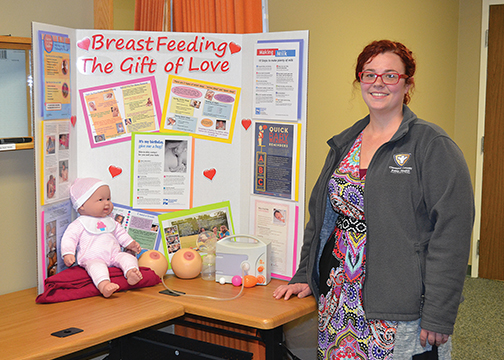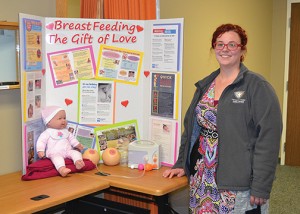

Sun staff
More than 77 percent of mothers in Ohio are choosing to breastfeed their newborns, up from 70 percent in 2014, according to the U.S. Centers for Disease Control and Prevention 2016 Breastfeeding Report Card, released in August.
The report card does indicate, however, that Ohio falls below the national average for breastfeeding, which is more than 81 percent.
While county specific information is not yet available – the Ohio Department of Health’s Office of Vital Statistics is still compiling information, and a report is expected within the next couple of months – Katherine Schneider, director Clermont County’s Women, Infants and Children program, said that what she’s seen at the county level mirrors the Report Card findings for the state.
“We see the same trends as far as initiating breastfeeding – there’s higher rates there – and then, in the beginning, even in the first couple of weeks, they tremendously drop,” she said. “Even just the duration; it just doesn’t last.”
The American Academy of Pediatrics advises that newborns be exclusively breastfed for about the first six months, followed by breastfeeding in combination with the introduction of complementary foods until at least 12 months of age, according to the organization’s website.
Breastfeeding protects babies against a variety of diseases and conditions, including bacteremia, diarrhea, respiratory tract infections, urinary tract infections, type 1 and type 2 diabetes, leukemia and Hodgkins disease, and childhood overweight and obesity, according the APA website.
Reported maternal health benefits include decreased postpartum bleeding and more rapid uterine involution, decreased menstrual blood loss and increased child spacing, earlier return to pre-pregnancy weight and decreased risk of breast and ovarian cancers.
A comparison of the CDC Report Cards from 2014 and 2016 shows that breastfeeding rates continue to rise across the country. In 2014 – no report card was available for 2015 – 79.2 percent of newborns were breastfeeding, while 49.4 percent were breastfeeding at 6 months and 26.7 percent were breastfeeding at 12 months.
In 2016, 51.8 percent of newborns were breastfeeding at six months, and nearly a third, or 30.7 percent, were breastfeeding at 12 months.
The 2016 Report Card shows that in Ohio, 77.7 percent of newborns started to breastfeed, 43.8 percent were breastfeeding at 6 months and 25.6 percent were breastfeeding at 12 months. Those numbers are up from 2014, when 70.1 percent of newborns in Ohio started to breastfeed, 42.1 percent were breastfeeding at 6 months and 21.6 percent were breastfeeding at 12 months.
WIC is a nutrition education and supplemental food program aimed at improving the nutritional status of mothers, infants and children during critical stages of growth and development, according to the county’s WIC website. Clients must meet income guidelines in order to participate.
WIC currently serves close to 3,000 clients, and Schneider estimates that about a quarter, or 750 clients, are women who are being courted to participate in the county’s breastfeeding program, which follows APA recommendations; 173 are currently enrolled.
Most of the county’s WIC clients who stop breastfeeding said they’ve done so because of lack of support, according to Schneider.
“So there’s issues within the family unit,” she said. “Or, even as far as if they’re going back to school or work, and there’s not an easy way to use a breast pump.”
Introducing formula can also cause a woman to stop breastfeeding, Schneider said.
“[The baby’s] nutrition needs are not being solely met by the mother, so that leads to a depleted milk supply,” she said, adding that an early introduction to bottles can create problems too.
“It can cause nipple confusion as far as switching between bottle and breast, because bottle feeding, the way an infant responds to that, is different then breastfeeding,” she said. “And then the mothers think there’s issues of not enough breast milk there; that is often correlated.”
The county’s WIC program is designed to try to prevent that from happening, Schneider said. Three part-time breastfeeding peers and a part-time lactation consultant are on staff.
“We have our breastfeeding peers who make contact throughout pregnancy to best prepare them on what to expect and educate them on how to be successful at breastfeeding, for those who are interested in learning more about it,” she said. “During their breastfeeding experience, we keep in very regular contact to try to catch issues that might come up to prevent them from stopping breastfeeding.”
She added, “But, we see in our WIC population here in Clermont County, the trends, that even with all that support, a lot times there are women who will try and then they will stop.”
For more information about the Clermont County WIC program, visit their website at www.clermonthealthdistrict.org/WICBFSupport.aspx.
